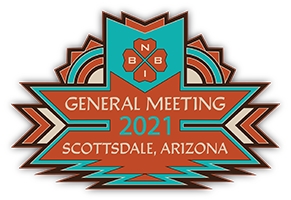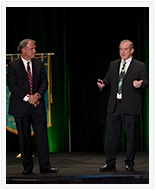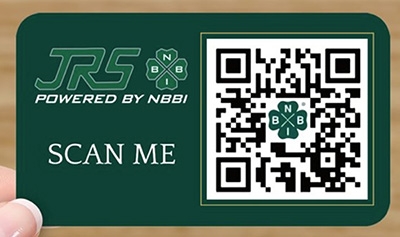
89th General Meeting Speaker Presentation
"JRS Presents"
Mark Mooney and Jacques Couvillon
The following presentation was delivered at the 89th General Meeting Monday General Session, May 10, 2021. It has been edited for content and phrasing.
 INTRODUCTION: Mark Mooney is the director of operations for NBBI JRS. Mr. Mooney served as the Massachusetts chief boiler inspector for 12 years before joining Liberty Mutual, where he oversaw the commonwealth’s jurisdictional inspection and licensing program for elevators, amusement devices, boilers, and pressure vessels. A former member of the National Board’s Board of Trustees from 2001 to 2009, Mooney maintains a Massachusetts 1st Class engineer’s license, along with a National Board Commission. He has held jurisdictional commissions in 35 states.
INTRODUCTION: Mark Mooney is the director of operations for NBBI JRS. Mr. Mooney served as the Massachusetts chief boiler inspector for 12 years before joining Liberty Mutual, where he oversaw the commonwealth’s jurisdictional inspection and licensing program for elevators, amusement devices, boilers, and pressure vessels. A former member of the National Board’s Board of Trustees from 2001 to 2009, Mooney maintains a Massachusetts 1st Class engineer’s license, along with a National Board Commission. He has held jurisdictional commissions in 35 states.
Jacques Couvillon is the director of product management for NBBI JRS. Mr. Couvillon spent 16 years as the director of regulatory software for Praeses, a software and IT services company, where he served as the business leader for Jurisdiction Online, a software that supported jurisdictional object workflows (boilers, pressure vessels, amusement rides, elevators, etc.) for state governments and the insurance carriers required to report to them. Couvillon also served as the Director of Product Management for CentralSquare’s Public Administration Business Unit, where he managed a $22 million software suite supporting municipal government workflows that included products focused on permitting and inspection, finance, asset management, HR, and a citizen portal.
Their slide presentation can be accessed HERE. Step-by-step videos from their presentation are inserted directly above where they correspond with the transcript.
MR. MOONEY: Before we share with the audience the app that we have been working on with The Ohio State University Capstone Team, why don't we give you give a little bit of history of what we are doing there.
MR. COUVILLON: Our first executive director had a working relationship with Ohio State. C. O. Myers contracted with the Robinson Lab in 1935 to conduct relief valve testing. That activity continued for 37 years, until 1974 when the National Board built its first lab. When we started working with JRS, we reached back out to Ohio State to reinvigorate that relationship, and they gave us a Capstone Team to help develop a mobile app to calculate remaining life and minimum thickness. I would like to introduce that Capstone Team to you today. Ladies and gentlemen, this is our Capstone Team. (Appearing via Zoom.) Give them a wave. This is Alec, Noah, Jonathan, Vish and Anish. These guys did a great job working with us. We appreciate you being here with us today. Thank you very much.
MR. MOONEY: When I was out doing field inspections, I'd do an inspection on a boiler or a pressure vessel – in this case, pressure vessel – and I would bring with me a spreadsheet I had put together that had the code calculations. But since it was a printed sheet, I had it only for the stress value of a typical air tank, and it only gave a particular head calculation. Otherwise I would have a whole bunch of sheets. So, there was a little bit of difficulty not having something other than a piece of paper. And after I did the calculations for the vessel’s remaining life, I would have to go back to the office and do the calculations with it.
On your phones you take the camera, and we will have a QR code (at the end of the presentation) that you can scan with your phone. It will pull up the app location, which will enable you to select what type of phone you are using, whether you are using an Apple phone or an Android. You select that. From there you can hit the download button. It will download the application to your phone. Once it's downloaded, you click the open button, and it brings you to our Terms & Conditions page, which you can take your time to read through it, or you can scroll right to the bottom and click the “Agree to License” button, which brings you to the main screen.
In our main screen functions, we have: the Minimum Shell Thickness (in.) and the Minimum Head Thickness (in.), which is what will be displayed when you start inputting the inputs. We have a Type of Head that you can select based on the air tank or pressure vessel that you are using. In this case you have Hemispherical, Conical, Ellipsoidal, Segment of a Sphere, or Torispherical heads that you can choose from. And when you pick one, for instance Conical, the app will pull up the values needed in that equation. The same for Hemispherical. You then scroll down to the Material selection, and it allows you to select different materials that you may want to use. For our exercise we are going to use basic Carbon Steel Grade 60. It gives us a Stress Value of 17100.
You then input the maximum allowable working pressure – MAWP (PSI), and you do that by either going to the arrow keys down to the space, or you can click on it. And then the Diameter (in.) of the vessel. In this case we are going to put in 20. And then you can scroll down to the Joint Efficiency (%). Now, from there you have the middle tabs, which give you the Minimum Thickness, Pressure Allowed, and Remaining Life. We have seen from the input that we have here Minimum Shell Thickness (in.) of 0.118, Minimum Head Thickness (in.) of 0.094. When you go to the Pressure Allowed tab or the Remaining Life tab, there are further calculations, which we will explain in a little bit.
MR. COUVILLON: Why don't we walk the group through some day-in-the-life-type examples.
MR. MOONEY: In our first example, we've got a routine air tank. So in this situation, we are going to use a typical Hemispherical head, we are going to select Carbon Steel Grade 60, again we will use a MAWP of 200 PSI, a Diameter of 20 inches, and we will use a Joint Efficiency of 100%. It gives us a Minimum Shell Thickness (in.) of 0.118 and a Minimum Head Thickness (in.) of 0.094, as we have seen before.
In this example, to enter the actual thickness we go to the Pressure Allowed tab. So now the inspector will input the actual thickness that they see when they UT the vessel. In this case I'm going to put .2 for the shell and a .2 for the head. It gives us a Calculated Pressure of 337 PSI.
But as we saw in the first screen, the PSI is 200 – the MAWP is 200. This isn't giving you a license to increase the MAWP; it's just telling you what the calculation was. You want it to remain the MAWP where the code tank is set for.
And then the next step in the process is determining the remaining life of the vessel. So what you are going to do is select the Remaining Life tab, it's going to bring you to a page where you are going to enter the Previous Thickness of Shell (in.). In this case we will use .25. Previous Thickness of Head (in.), we will use .25 in this example. And the Previous Reading, the reading you did last year, I will use a date of January 1, 2020, which is about a year ago. And if we look, it gives us the remaining life of two years, two months with the Projected Date of Pressure Reduction at 7/12/2023. Keep in mind that our minimum thickness was 0.118 at the time for the shell, and you have had a pressure reduction of .05 inches per year. When you just think, do the quick math, it's going to take about two years by the time you get to the minimum thickness, and at that point it's time for a new vessel.
MR. COUVILLON: So, I can see how that would be great information for the owner to have in capital budget planning and planning for expenditures. Does it support vessels of all sizes?
MR. MOONEY: That's a very good question, Jacques. Unique or irregular vessels, there are cases where vessels are constructed outside of the ASME Code, Section VIII, Division 1, or if they exceed the parameters allowed by the code for the use of the standard formulas. For instance, in Part UG-32 it gives us the calculations that this application uses. However, if we expand this out to say the hemispherical heads, it will say, “When the thickness of the hemispherical head does not exceed 0.356L, or P does not exceed 0.665SE, the following formulas shall apply.” So, if they do, you don't want to use that formula, and we want the app to point the inspector back to the code.
In our example here, we will use exactly that. Let's say the MAWP is 7,000 PSI. That's going to put us out of that range there. We'll say a Diameter (in.) of 20, and the app will tell the inspector this isn't going to work for this vessel, you've got to “Refer to Code.”
If the vessel is determined to be below minimum thickness, the app will calculate the MAWP for the thickness provided. That's a neat thing. It can be useful for the owner if they wish to appeal to the state or the jurisdiction to have the vessel used at a reduced pressure. An example of this: we will go to the Pressure Allowed tab in a second. So, we have the Minimum Shell Thickness (in.) of 0.118. We are using MAWP (PSI) of 200. We want the Current Thickness of Shell (in.) to be below 0.118. Let's use .08 as an example. We will use the Current Thickness of Head (in.) being above the minimum thickness of .2. And as you can see, it calculates out the Pressure Allowed (PSI) to be 136, which is below the MAWP of the original vessel, but it's based on the current thickness of the vessel. We then move to the Remaining Life tab, which is an interesting thing because we know there is no more life here, right? The previous vessel thickness was .25 for each both, the shell, and the head. And you notice, the app says, “Invalid Input.” And the reason why it says that is because there is no more remaining life. You are below the minimum thickness. So, it's not an error; it's just telling you it's time to replace the vessel.
MR. COUVILLON: I can see how that would be valuable information for the owner to have and save them money long before they have to scrap the vessel. Now that we have walked the audience through the app, why don't we hand out some QR codes so that they can download the app and start to work with it. We hope you enjoy your time in Scottsdale and the rest of the General Meeting, and we look forward to seeing you again next year in New Orleans. Thank you.
